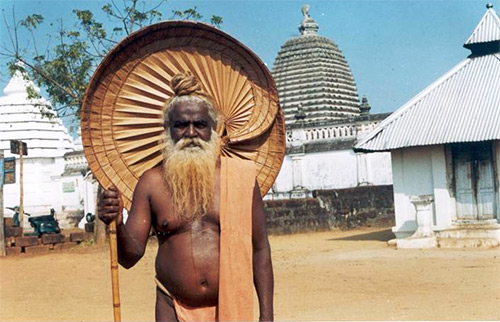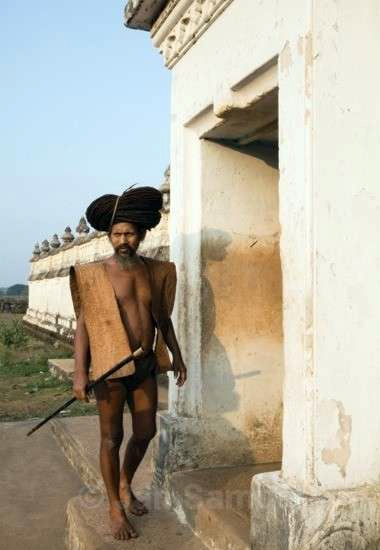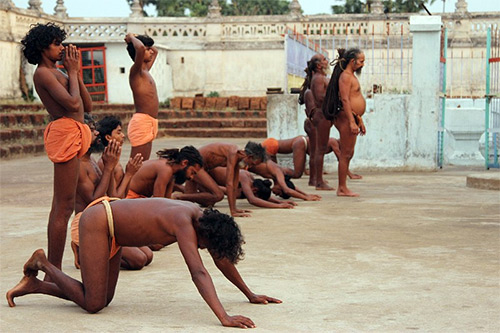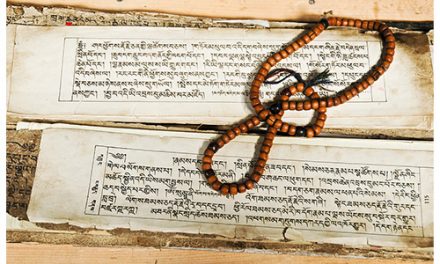
If you happen to see a man clad with saffron robe, having knotted hair on his head, a bag dangling from his shoulder, a palm-leaf umbrella over his head, walking with down-ward glance, singing Bhima Bhoi’s Bhajans to the music of his castanet, prostrating before sunrise and sunset, smearing his forehead with dust or eating from an earthen pot or leaf plates, sleeping beneath the open sky beside a burning log or Dhuni, you can instantly conclude, here is a Mahima Baba or a Kumbhipatia Baba, (Satya Mahima Dharma 12-18).
Mahima Dharma is a religion founded by one Mukunda Das alias Mahima Swami who hailed from Baudh ex-state and belonged to a Brahmin family. At first he was in charge of Balasingha Math of Baudh. He attained siddhi at Kapilas hill in 1862 A.D., founded Mahima Dharma, from there came to Balasingha and initiated his first disciple, Jagannath Das of Balasingha and renamed him as Govinda Das.
The poet prophet of this religion was Bhima Bhoi, whose samadhi at Khaliapali village situated at a distance of around 12 km to the west of Sonepur town has become a place of pilgrimage for the followers of his faith. The Mahimaites touch no prasad or tulsi leaf or medicine. They entertain no casteism or idolatry or belief in spirits. They play no games, move with no sanyasini, sit under no canopy, domesticate no birds or animals. They do not accept alms from astrologers, prostitutes, barbers, Brahmins, Kshatriyas (Rajas) and Chandals.
Like the Vaishnavas, they wear no sacred threads, no tilak or mark of Vishnavism, no garland of beaded tulsi. They take no dinner, touch no food which is too salty or too sweet or too bitter. They perform sarana and darsana, beg food only once from a family, stay only a day in a village. They practise truth, non-violence and believe in immortality and rebirth. Born in an atmosphere of suppression and distrust, Mahimaism opposed the spread of Christianity and Vaishnavism. It resembles Christianity in its belief in one God and one caste and also in bridal and funeral ceremonies. But unlike Christianity its God is Alekh.

Like Vaishnavism, it is based on faith, but it runs to philosophic abstraction. (To scholars like B.C. Mazumdar and L.N. Sahu this religion is the culmination of Jainism for its saffron robe, its non-violence, its code of conduct and its custom of fasting at night, while to others, it is the modern form of crypto-Buddhism for its theory of the void, its projection of Mahima as Buddha, non-attachment and rejection of casteism, idolatry and the Vedas. But to Dr. N.N. Basu and Professor A.B. Mohanty, Mahima religion evolved from Mahayana Buddhism. To Pandit Vinayak Mishra, it is a branch of Sahajayana. To Pandit Nilakantha Das, it is Tantrayana which developed into a distinct cult. The Buddhists believe that in the ultimate there is Nothing, but to the Alekhist, there is only One after all the appearances disappear. That again has no appearance.
Like Sankaracharya, the Mahimaites believe in Monism, but they have no place of Maya in their scheme of things. Though Mahima religion bears the stamps of Jainism, Buddhism, Christianity and Hinduism, it has its own indissoluble identity. Mahima Dharma contains the essence of all cults of the world. Orissa during the 19th century, in the context of the Indian renaissance and the social and political changes which took place all over the world was indeed a virgin land for the rise of the Mahima Dharma.
Mahima Dharma originated in Orissa in the second half of the 19th century. It took its birth out of the two great religions i.e. Hinduism and Buddhism. Mahima Dharma is the last protest of saints against the established Hindu religious order. The great Prabuddha Guru Mahima Gosain founded and preached the religion called “Mahima Dharma”. Mahima Dharma is also called “Satya Sanatan Mahima Dharma”. It is Satya and Sanatan, being a branch of the Sanatan Hindu Dharma.
The philosophical truth on which Satya Mahima Dharma is founded is that, “The ultimate reality is One and the only One. The human mind through ages has worshipped the One as manifested in many. But the true worship is, in the words of Bhima Bhoi “to come down to the stem leaving the branches”. In other words, to withdraw from the many to One and the only One. This theory of oneness of the Supreme Reality of the One and only one God is known in Indian philosophy as Advaitabada. Advaitabada has been the doctrine of many great philosophers of India like Shankaracharya (9th century) and Ramanuja (11th century).
Shankara’s Advaitabada is termed as Nirbishesa where Brahma or Ultimate Reality is One and the only One. Ramanuja’s Advaitabada is termed as “Visistha Advaitabada” or the special theory of Advaitabad. Mahima Dharma’s Advaitabada is termed as Visuddha or pure Advaitabada. It is based on both Shankara and Ramanuja’s theory of Advaitabada, It states that Brahma is Advaita, but the world he has created is not Maya. The world has a separate existence, but only as Brahma’s Mahima or glory, says Biswanath Baba. But Prof. Ganeswar Mishra, the eminent philosopher of Orissa pointed out that Advaita Vedant does not become dualistic just because it talks of the world being created by the power of Maya or Brahma nor does Satya Mahima philosophy become pure Non-Dualism because of its claim that the world is created by the grace of the formless and shapeless being.

Advaita philosophy in believing that the world of name and forms is due to ignorance remain as much monistic as the Satya Mahima philosophy which believes that the creation of many things and being is real even though the ultimate reality is One, non-dual, formless and shapeless. According to Dr. A.Echmann, Mahima Dharma takes up the Buddhist concept of emptiness and identifies it with the Hindu conception of Param Brahma and “Isvara Purusa”. Sunya Param Brahma is characterized more precisely with the concepts of Alekha, Nirakara, Anadi, Niranjana and Mahima, all of which already appear in the medieval Oriya Literature for describing Sunya Brahma or as synonymous for him. Ultimately Sunya came to be treated as the attribute of a personal God who can be attained through devotion. This God in fact was supposed to have the twin attributes of “being no where” and “being everywhere”.
The Source of Mahima
Dharma Mahima Dharma was propagated by Mahima Gasain alias Mukanda Das of Baudh during the 19th century. The religion which he preached through some of his disciples is pure monotheism identical with the doctrine of the Vedanta or Upanishad. The movement of Mahima cult was not an isolated movement.
Chaitanya Das of Khadial is regarded as the originator of Mahima cult. He has cited Brahma Purusa as the Creator of the Universe and like Mahima Dharma discarded idolatry and caste system and idol worship in his “Nirguna Mahatmya” and “Vishnu Garva Purana”. Later on Sadhu Chandramani Das of Baghapali, Sonepur explained the illogicality of Hindu Caste system and idol worship in his “Sudhasara Gita”. Both Chaitanya Das and Chandramani Das were senior to Bhima Bhoi.
Mahima Dharma protested against the evils in the social sphere. The revolt was against the prevailing social order and against the prevailing religious ideas. It tried to teach the people a simple set of doctrines to liberate the souls from the bondage of sufferings. This cult rested on indigenous foundations and had nothing to do with external forces. In short, Mahima cult is a revivalism of the Vedantic thrust and a reformist movement of Orissa within the Sanatan Hindu fold.
The synthesis existing in Mahima cult comprehends many opposites such as Brahminism and anti-Brahminism, eastern and western traditions, Hinduism and Islam. Inspite of all traditions, the basic Indian tradition is not completely lost. It is a unique synthesis since its uniqueness does not lie in merely placing together but in bringing up a complete harmony of the divergent philosophical and religious trends and exhibit the emergence of a new light which is a class of its own type. Mahima dharma in incorporating all the higher values cherished by the values of past thinkers e.g., compassion, love, tranquility and detachment, and by giving a personal God in the Mahima Gosain himself, who is to be attained more through a fullness of heart than through pedantic learning, met all the claims of a theistic religion. (Mentioned in an article by Dr. N. Padhi.)
Mahima Gosain
It is revealed from the Proceeding of the Asiatic Society of Bengal, January 1882 that the founder of Mahima Dharma is Mukunda Das. He appeared at Puri in 1826 and lived for a long time, there as an Achari-Vaishnab and was known as Dhulia Babaji from the fact of smearing his body with ashes. He left Puri and came to Dhenkanal where he selected the Kapilas hills near a shrine of Mahadev as his dwelling-place.
During the first twelve years of his residence at Kapilas, Mukunda Das lived on fruits and accordingly was known as the Phalahari Babaji. The next twelve years passed on by taking milk and water which secured him cognomen of Khira-Nirahari. During his sojourn at Kapilas, he was known to be a devout worshipper of the local deity and took much pains in improving the place by cutting the jungle, making gardens, looking after the Bhog or sacred food of the idol and taking care of the pilgrims who were visiting the place periodically.
This procured him the respect of the mother of the late Maharaja of Dhenkanal who supplied him milk as food every day. He gradually succeeded in securing the respect of the people of the surrounding villages, and there developed a popular belief that he was in secret communion with the idol. After remaining at Kapilas hills for several years and finding that he had sufficiently established his reputation and commanded respect of the people, Mukunda Das left the place and began to preach that various idols worshipped by the Hindus were nothing else but stone and wood and that the worship of these articles was useless and of no avail, that the Creator of the Universe was Alekh or Mahima , a spiritual being without form and that he alone could hold communion with him and get his prayers granted.
He eschewed his Kaupin and Kanthi and wore Kumbhipat to cover his nakedness. Afterwards he came to Daruthenga where he built a tungi and commenced to propagate the new doctrine. It was at this place that Mukunda Das was deified and began to be addressed as the Mahima Gosain. The then manager of Dhenkanal pointed out that the man who was at first called the Phalahari Gosain was afterwards designated Mahima Gosain and was believed to be an incarnation of the Almighty God.
Mahima Gosain breathed his last in 1876 A.D. The death of Mahima Gosain gave a great shock to his followers who used to look upon him as the Creater of the Universe and Sunya Brahma. The followers of Mahima cult were divided into three sects even at the time of Mahima Gosain. They were Kumbhipata, Kanapatia and Ashrita. The annual festivals held at Mahulpada and Joranda were generally attended by Kanapatias and Kumbhipatias respectively.
After the death of Mahima Gosain the followers were divided into three groups, known as Chhapanmurtia, Tetis murtia and Kodie murtia according to number of Sanayasis in the group. The reason of the division was due to wearing of Balkala and Kaupina.
Gradation of Sanyasis
There are no gradation of Sanyasi-hood among the followers of Kaupindhari Mahima Samaj. But Balkaladhari Mahima Samaj have three successive stages known as Bairagi, Apara Sanyasis and Para Sanyasis. These stages have been newly created by the Balkaladhari Sanyasi Biswanath Baba and not by Mahima Gosain, the founder of Mahima cult. The Kaupindhari Mahima Samaj of Joranda do not accept such distinction. This is also not found in the literature of Bhima Bhoi.
In course of time, a large number of people in Orissa became devotees of the cult. Gradually it also spread to the neighbouring states like Andhra, Assam and Bengal. The early history of Mahima Gosain was shrouded in mystery due to lack of proper research. He appeared for the first time in 1826 at Puri as Dhulia Gosain and Hindu Baishnaba. He was born in the last part of 18th century in Baudh ex-state as a son of Ananta Mishra. He was Brahmin by caste as mentioned in Mahima Vinod of Bhima Bhoi in Vol.11. He attained Siddhi in 1862 A.D. at Kapilas hill of Dhenkanal and propagated his newly founded Mahima Dharma for the last fourteen years of his life.
Besides the Sanyasis, there are lay devotees of this cult and the latter constitute the bulk of Mahima followers. Hindus worship Brahma and all other minor deities whereas Mahima Dharma is based on the Philosophy of Brahma worship only. The first convert to the Mahima cult was Govinda Baba alias Jagannath Das of Balasingha, Baudh. Bhima Bhoi, the first poet of the cult was the second disciple of Mahima Gosain. It was chiefly owing to the exertion of the disciples of Mahama Gosain that the religion was propagated.
The followers of Mahima Dharma belong to various castes and tribal sections. Mahima Gosain, the founder of Mahima cult wrote no books. He preached his teachings by oral instructions. He has been described by Bhima Bhoi to be old having emaciated body, matted hair, sometimes clad on Kaupin or loin cloth and sometimes on bark. Both Bhima Bhoi and his Guru Mahima Gosain have been turned into legendary figures by the followers of Mahima cult.
Bhima Bhoi
Bhima Bhoi was born at Jatasinga near Subalaya of Subarnapur district. Previously Jatasinga village was in Rairakhol ex-estate. There is a palm grove on the bank of a pond on the outskirts of this village where the infant was abandoned by his mother. Later on he was initiated by his Guru Mahima Gosain in his own cottage. A considerable knowledge of his Guru’s teachings is handed over to us by the writings of Bhima Bhoi. The very essence of Mahima Dharma is echoed in the writings of Bhima Bhoi.
The obvious advantage that he enjoyed was that he had the company and darshan of his guru. His writings are, therefore, the only original source materials of Mahima Dharma. The writings of the poet are second to none, being original, authentic and real. It is learnt from the writings of Bhima Bhoi that Mahima Gosain himself blessed him and asked the poet to give expression to the basic teachings of Mahima Dharma in his poetry.
The philosophy expressed by Bhima Bhoi is “Bhakti Yukta Gyana Marga” and not “Gyana Bhakti Marga” as expressed by Biswanath baba. Mahima cult, as expressed by Bhima Bhoi is basically a humanist cult. It believes that a house holder and a worst sinner can attain deliverance through devotion to Alekh. Thus he has drawn a synthesis between the life spiritual and life temporal. Bhima Bhoi modified the tenets of Mahima cult and became himself the “Guru” of a new form of Mahima religion.
It is a phenomenon of great significance that Bhima Bhoi belonging to the Kandha tribe and became the progenitor of a religious system which disowns caste system and idolatry. He declared for the first time in the field of religion that “Yoga” or meditation and “Bhoga” the pleasurable are one and the same. He maintained the same status for both. He himself practised it during his life time. Although he became a “Gruhi Bhakta” or householder disciple after the death of his Guru Mahima Gosain in 1876 A.D, he was doing the duty of a Mahima Sanyasi by preaching Mahima cult and initiating thousands of disciple.
The following illuminating lines of Bhima Bhoi have made him world famous.” Boundless is the anguish and misery of the living who can see it and tolerate Let my soul be condemned to Hell But let the Universe be redeemed.” It was believed that Bhima Bhoi was born blind. But now it has been proved that he was not blind. After the death of his Guru Mahima Gosain in 1876, he returned from Joranda to Khaliapali with a broken heart and tried to reorganize the Mahima Dharma in a different way. Bhima Bhoi in Khaliapali did not live the life of a Sanyasi. He made up his mind to organize a monastic institute after his own idealism.
Annapurna, his spiritual consort was a Sanyasini and was living with him in Khaliapali Ashram and was initiating the female devotees. Besides Annapurna, there were four other consorts of Bhima Bhoi. Bhima Bhoi died in 1895 A.D. when he was hardly 45 years of age. A Samadhi temple was constructed at Khaliapali after his death in his sacred memory











